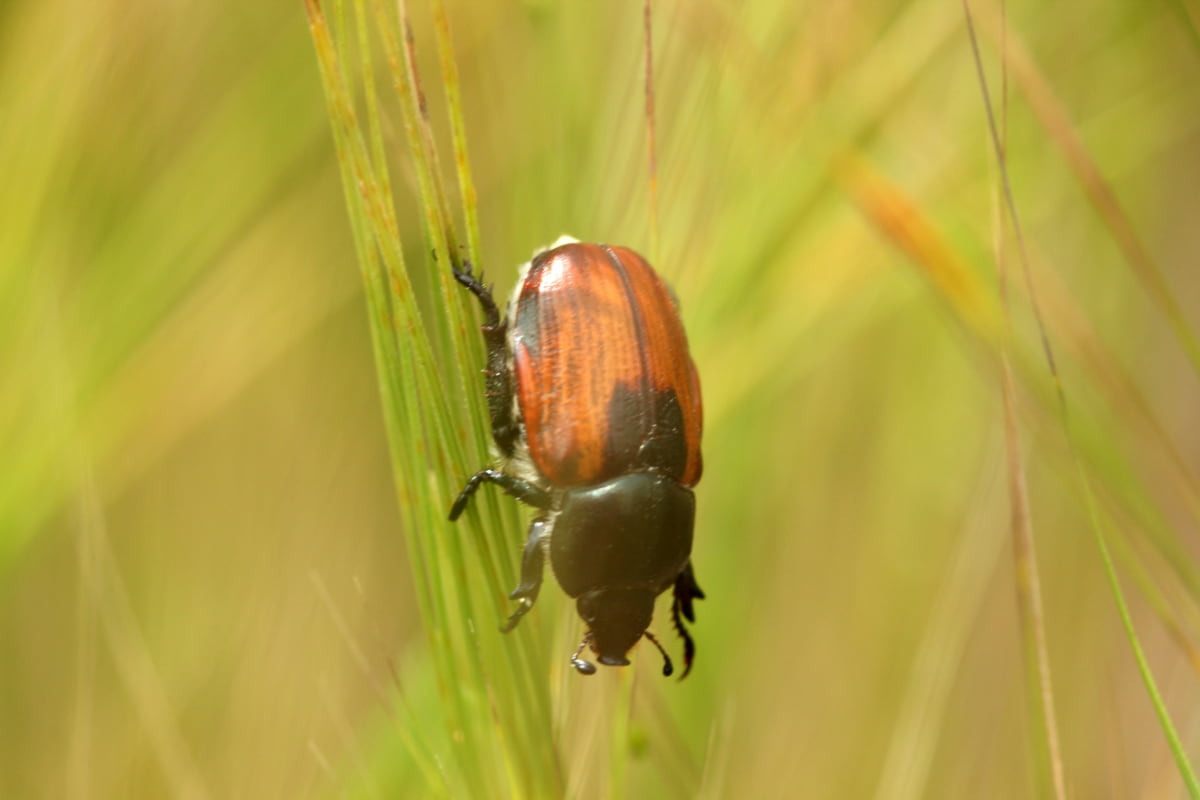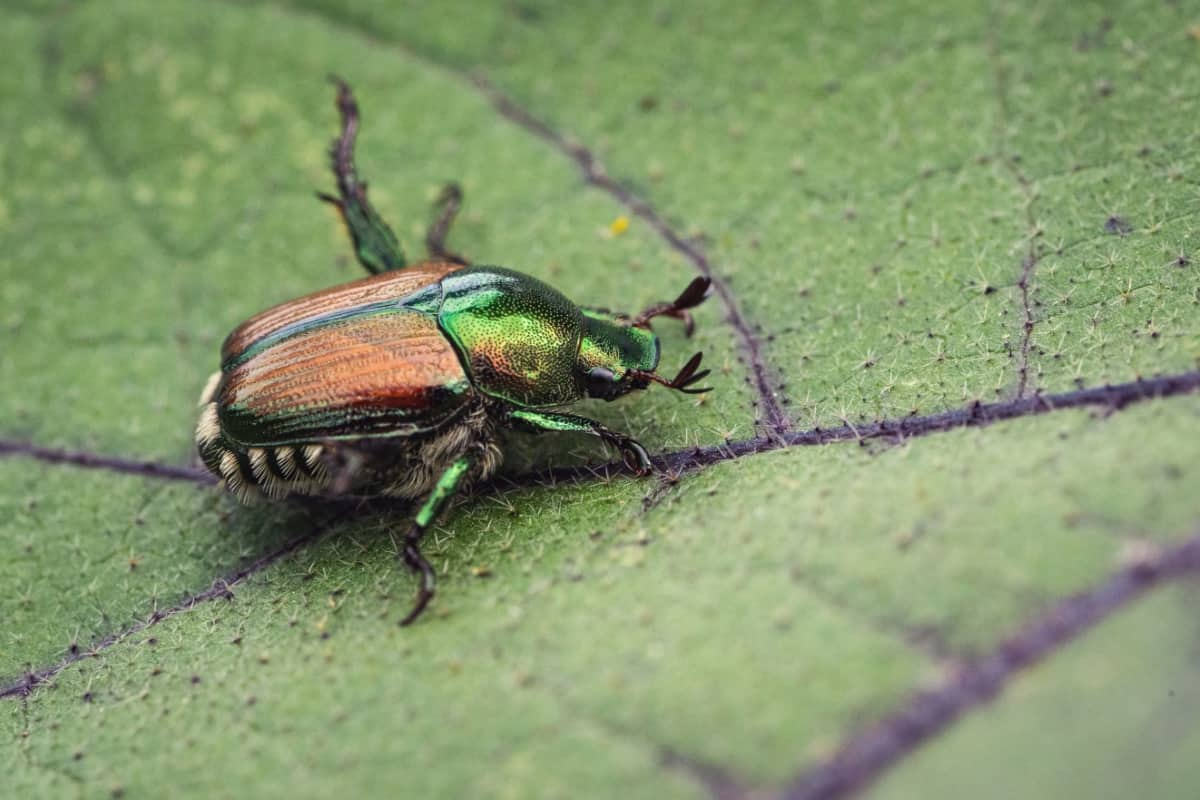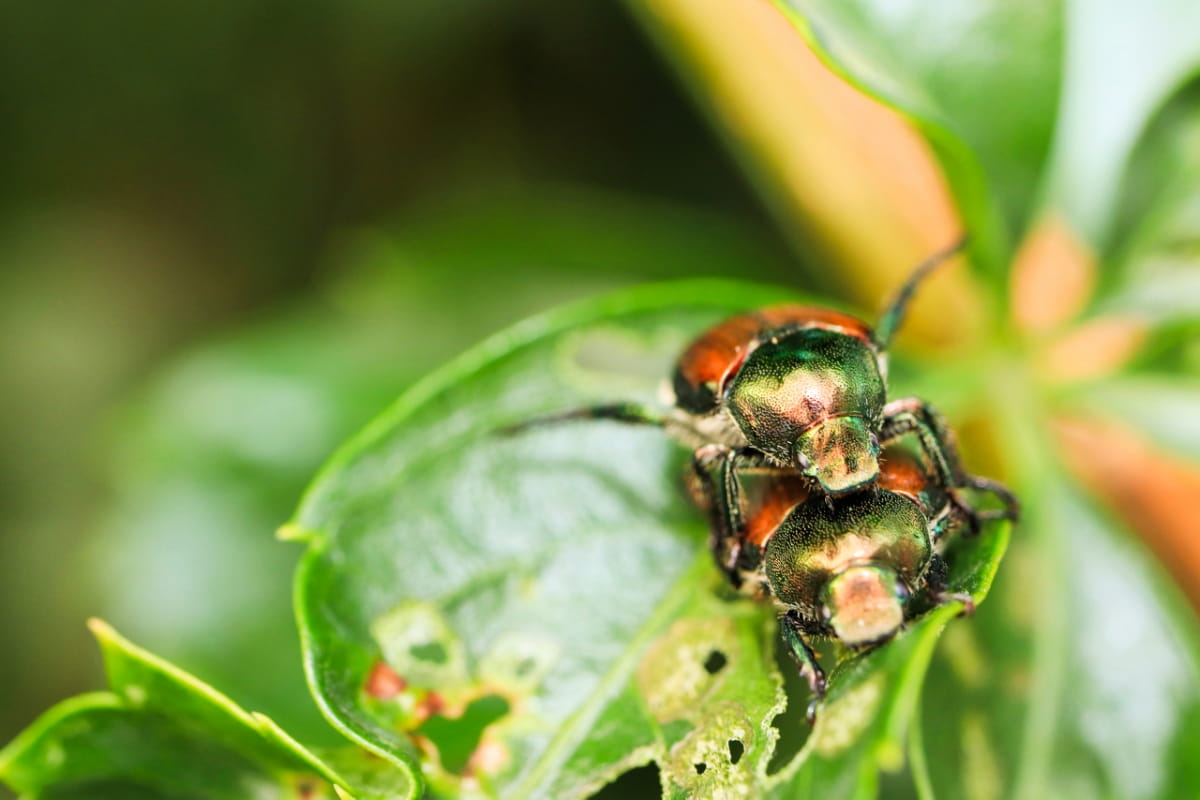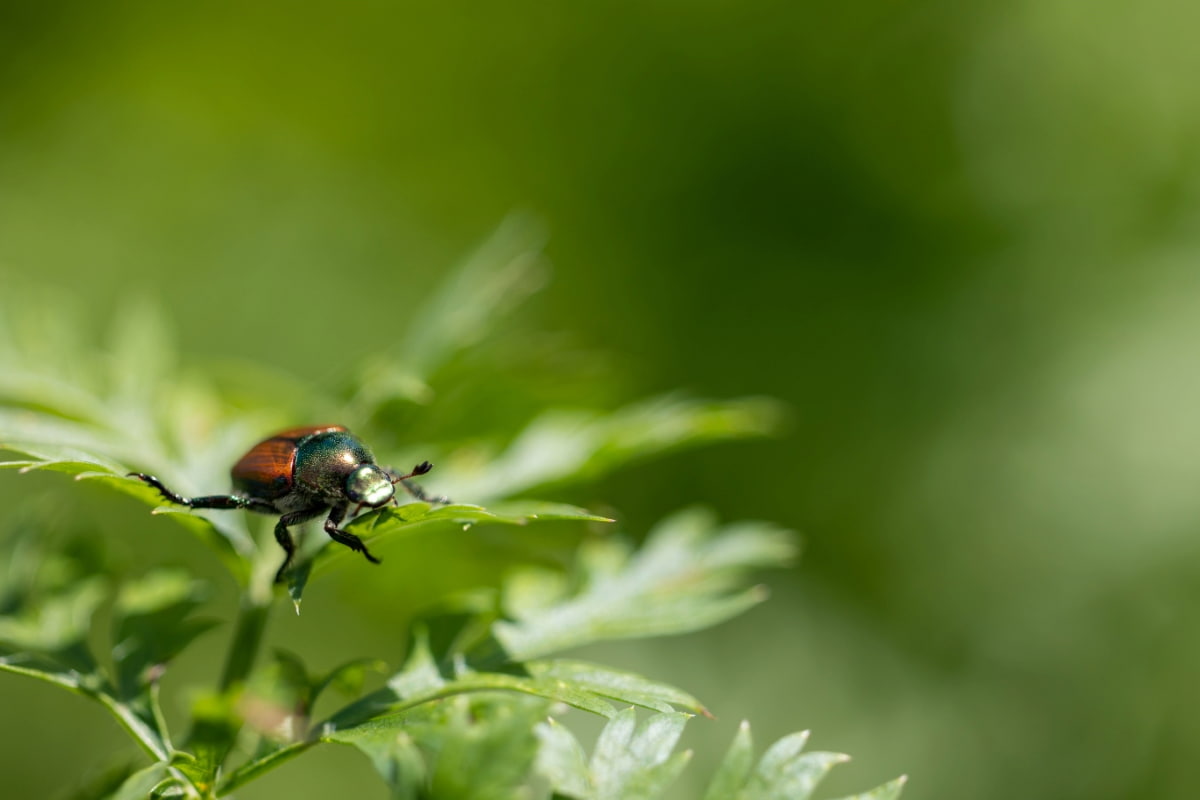Greetings and welcome to the war against Japanese beetles, the infamous garden invaders who wreak havoc on vegetables and flowers. Prepare yourself by learning easy ways to keep your garden safe. We’ll look at practical, doable remedies, such as strategically placed plants and natural repellents. Build a healthy, pest-resistant garden haven and bid farewell to Japanese beetle annoyances.

How to Deal with Japanese Beetles
Understand the Japanese Beetle Life Cycle and How They Affect Gardens
They are 1-inch long, white, c-shaped grubs that feed on plant roots before they mature into adult beetles in June. They can cover extensive land and are desperate despite their short lifespan. Even if you manage the number of beetles in your area, they may still visit your neighbor. Japanese beetles chew leaf tissue between veins, leaving a lacy skeleton. They can be identified by their skeletonized leaves, similar to Mexican Bean Beetles. They are often near damaged leaves, so inspect the plant thoroughly and monitor the ground, as beetles may drop off if disturbed.
Use Integrated Pest Management Methods to Control Japanese Beetles in Gardens
Integrated Pest Management (IPM) can effectively manage Japanese beetle infestations in gardens. This involves encouraging natural enemies like nematodes, predatory insects, and parasitic wasps, using neem oil as an insecticide, implementing barriers like row covers, handpicking beetles in the morning, and strategically placing pheromone traps. Regular monitoring and adjustments to control strategies can reduce environmental impact and promote a stable, thriving garden ecology. This comprehensive approach reduces negative environmental effects while controlling Japanese beetle populations.
Identify Japanese Beetle Damage and Effective Prevention Techniques for Gardens
Japanese beetles are voracious eaters, leaving distinctive damage on plants. Look for skeletonized leaves, where the beetles consume leaf tissue between veins and irregular holes. These pests often target roses, grapes, and fruit trees, weakening plants.
Prevention Techniques
- Companion Planting: Planting repellent species like garlic or chives alongside susceptible plants can deter Japanese beetles.
- Handpicking: Regularly handpick and drop Japanese beetles into a soapy water solution to control their population.
- Neem Oil Application: Neem oil, a natural insecticide, disrupts the life cycle of Japanese beetles without harming beneficial insects.
In case you missed it: How to Prevent Flea Beetles in Your Garden: Homemade Natural and Organic Treatment to Get Rid of Them

Manage Japanese Beetles in Flower and Vegetable Gardens Using Organic Methods
Japanese beetles can significantly damage vegetable and flower gardens. Organic methods can help control their population by using neem oil extracted from neem trees, milky spores, nematodes, and repellent plants like chrysanthemums and garlic. Rotating crops frequently and using natural deterrents like chrysanthemums and garlic can also help. These methods avoid harmful chemicals and ensure a healthy, balanced landscape without damaging the plants.
Choose Resistant Plants and Companion Planting to Discourage Japanese Beetles
Opt for plants like marigolds, chrysanthemums, and petunias, which are known for their resistance to Japanese beetles. Companion planting is a useful strategy for preventing pests like Japanese beetles. Planting garlic, rue, or tansy near affected plants can deter beetles. Aromatic plants like geraniums, rue, feverfew, parsley, and thyme can also help. Other plants like sage, anise-hyssop, Russian sage, lavender, yarrow, oregano, catmint, and calamint can attract beetles to eat their poisonous leaves.
Use Biological Controls for Managing Japanese Beetles in Gardens
- Birds and Beneficial Insects: Encourage birds like starlings and beneficial insects such as parasitic wasps, which prey on adult Japanese beetles.
- Pheromone Traps: Consider pheromone traps to lure and trap Japanese beetles; however, use them strategically to avoid attracting more than you can handle.
- Companion Planting: Employ companion planting with beetle-repelling plants like garlic, rue, or tansy to deter Japanese beetles.
- Neem Oil: Utilize neem oil, a natural pesticide, on affected plants, disrupting Japanese beetle feeding and reproduction.
- Cultural Practices: Implement cultural practices like handpicking beetles early in the morning when they are sluggish.
Consider Chemical Control Options for Japanese Beetles in Gardens
Japanese beetles pose a significant threat to garden plants, necessitating efficient management measures. Chemical choices, such as neonicotinoids and pyrethroids, provide focused solutions for controlling beetles. Neonicotinoids disrupt beetles’ nervous systems, while pyrethroids cause rapid knockdowns. Systemic insecticides like acephate provide long-lasting protection. Label recommendations are crucial to minimize environmental impact. However, a comprehensive and sustainable management plan requires biological and cultural techniques and chemical control.
In case you missed it: How to Control Okra Leaf Beetle Naturally: How to Get Rid of This with Natural and Organic Treatment

Set Up Physical Barriers and Traps to Reduce Japanese Beetle Infestations
Japanese beetles can cause significant damage to gardens, but physical barriers and traps are effective management tools. By creating a physical barrier, row covers prevent adult beetles from deposting their eggs in the ground, protecting plants. These coverings are simple to install and should be in place from June through August when beetles are at their busiest.
To add another line of defense, lure and catch adult beetles with pheromone-containing traps. To entice the beetles away, place these traps thoughtfully far from the plants that are most susceptible to damage. By combining these physical obstacles and traps, you can protect your garden from Japanese beetle infestations by creating a robust defense.
Understand the Behavioral Patterns of Japanese Beetles for More Effective Garden Management
The peculiar feeding habits of Japanese beetles (Popillia japonica) include a preference for more than 300 different plant types. They are most active on hot, bright days and gather in bunches to maximize feeding efficiency. Aggregation pheromones released by adult beetles draw other beetles to feeding locations. It is essential to comprehend this behavior to manage gardens effectively.
Put control measures in place when things are most active, usually in late June or early August. Techniques like handpicking and applying neem oil can cause disturbances to their eating habits. Maintaining the health of garden plants and reducing Japanese beetle damage need prompt action based on behavioral understanding.
Develop Long-Term Strategies for Sustainable Japanese Beetle Control in Flower and Vegetable Gardens
Developing sustainable strategies for Japanese beetle control in flower and vegetable gardens is crucial. These voracious pests can wreak havoc on plants, causing significant damage. Integrated pest management (IPM) effectively emphasizes biological controls, such as introducing natural predators.
Neem oil, known for its insect-repelling properties, can act as a deterrent. Planting beetle-resistant varieties and rotating crops disrupt the beetle’s life cycle. Companion planting with repellent herbs like basil can also provide a natural barrier. Implementing these strategies fosters a long-term, eco-friendly solution, ensuring the health and vibrancy of gardens without resorting to harmful chemicals.
Frequently Asked Questions on Japanese Beetles
Are Japanese Beetles Harmful to Humans or Pets?
Japanese beetles are not harmful to humans or pets. They do not bite or sting. However, using certain insecticides to control them may pose risks, so following safety guidelines is important.
Are There Natural Predators of Japanese Beetles?
Yes, there are natural predators of Japanese beetles, including birds, parasitic wasps, and certain beetles. Tachinid flies, and predatory beetles are known to attack Japanese beetle larvae in the soil.
In case you missed it: Rose Flower Chaffer Beetle Pest Management: Symptoms, Treatment, Chemical, Biological, and Organic Control

Conclusion
Successfully managing Japanese Beetles in flower and vegetable gardens involves a multi-pronged approach. Employ neem oil or insecticidal soap for immediate control. Encourage natural predators like parasitic wasps. Plant beetle-resistant varieties and use row covers. Regularly handpick beetles when they are less active in the morning and drop them into soapy water for an effective, eco-friendly solution.
- Beneficial Insects in Pest Management
- Natural Solutions for Pest Control in Flower Gardens
- Types of Fungicides Used in Agriculture
- Common Issues in the Fruit Development Stage of Pomegranate Farming
- Fruit Development Issues in Papaya: Easy Solutions and Treatment
- Soil-Borne Diseases and How to Protect Your Plants
- Practices to Prevent Disease Spread in the Garden
- From Wilted to Thriving: How to Treat Root Rot Naturally in Houseplants
- Natural Remedies to Cure Brown Spots on Fig Tree Leaves